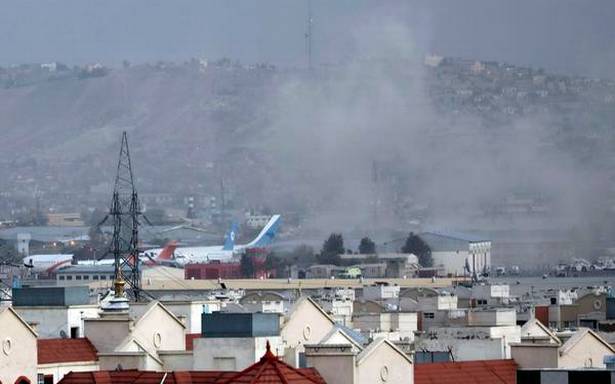Outfit has built network in Afghanistan and killed hundreds
In June 2015, a few months after the Islamic State (IS) announced its Wilayat Khorasan (Khorasan Province), the Taliban wrote a letter to the IS chief, Abu Bakr al-Baghdadi, asking him to stop recruiting jihadists in Afghanistan. The letter, signed by the then political committee chief of the Taliban, Mullah Akhtar Mansour (who would take over the insurgency in a month and be killed by a U.S. air strike in May 2016), said there was room for “only one flag and one leadership” in the fight to re-establish Islamic rule in Afghanistan. But the IS faction, which came to be known as the Islamic State of Khorasan Province (ISKP), did not stop recruiting disgruntled Taliban fighters. Nor did it stop launching terror attacks across Afghanistan.
On August 26, 11 days after the Taliban captured Kabul, the ISKP carried out one of its biggest attacks in Afghanistan, killing over 100 people in the capital, including 19 American service members, posing the first major security threat to Afghanistan’s new rulers, who themselves are no strangers to terror tactics. According to early reports, Kabul Airport, which saw chaotic scenes ever since the Taliban took the city on August 15 amid desperate efforts by Afghans to flee the country and frantic efforts by the U.S. and other foreign countries to evacuate their citizens, was hit by suicide and gun attacks. It was the deadliest day for the U.S. military in Afghanistan since 2011. The day also saw the first American fatalities in Afghanistan since the U.S.-Taliban agreement was signed in February 2020 under the Trump administration.
An IS branch
In the past six years, the ISKP has built an organisational network in Afghanistan from the eastern Nangarhar province, attracted followers from across South, West and Central Asia, and killed hundreds. When the Islamic State announced the formation of the Khorasan Province, referring to an area encompassing Afghanistan, Pakistan and Central Asia, in January 2015, the group’s immediate strategy was to exploit the divisions within the main jihadist groups operating in the region.
It appointed Tehrik-i-Taliban Pakistan (TTP) commander Hafiz Saeed Khan as its leader and former Afghan Taliban commander Abdul Rauf Aliza as his deputy (both were killed in U.S. strikes). It attracted members from different militant organisations such as Lashkar-e-Taiba, Jamaat-ud-Dawa, the Haqqani Network and the Islamic Movement of Uzbekistan into its fold, according to the U.S.-based Combating Terrorism Centre.
The ISKP declared its allegiance to Baghdadi. In operational tactics and ideology, it followed its parental organisation. The key goal is to establish “Islamic rule” in the “province” and for that they are ready to wage “jihad”. “There is no doubt that Allah the Almighty has blessed us with jihad in the land of Khorasan since a long time ago, and it is from the grace of Allah that we fought any disbeliever who entered the land of Khorasan. All of this is for the sake of establishing the Shariah,” the ISKP said in a video message in 2015.
When the IS in Iraq and Syria came under pressure in 2015 and 2016, the core organisation shifted its focus to Afghanistan. The IS was losing territories to Kurdish militias in Syria and government forces and Shia militias in Iraq. In Afghanistan, a divided country with the government’s writ hardly reaching its hinterlands, the IS saw an opportunity to rebuild its organisation. Having built its base in eastern Afghanistan, the ISKP issued propaganda messages, calling on Muslim youth across Asia to join the group. Many radicalised youth, including dozens from India, travelled to Afghanistan to either join the IS or live an “Islamic life” under the Caliphate’s rule.
Rivalry with Taliban
But the IS came under pressure in Afghanistan as well. The Taliban did not like its monopoly over violent jihad being challenged by another organisation. Also, the Taliban are a tribal, nationalist militant force, backed by Pakistan, whereas the ISKP doesn’t believe in national borders, and stands for a global Islamic Caliphate.
“The leadership of Daesh [IS] is independent, the goals of Daesh are independent,” Omar Khorasani, who was the ISKP’s top leader, told The Wall Street Journal earlier this month from prison. “We have a global agenda and so when people ask who can really represent Islam and the whole Islamic community, of course we’re more attractive.” The ideological and operational differences led to open clashes between the ISKP and the Taliban. When the Taliban seized Kabul and took over prisons, they freed several of their members, but executed Khorasani and other ISKP militants. Shahab al-Muhajir has been leading the terrorist group since Khorasani was arrested in April 2020.
Conflict continues
The U.S. has carried out a number of targeted attacks, killing several of the ISKP’s leaders. In April 2017, U.S. President Donald Trump ordered troops to drop the ‘Mother of all Bombs’, the most powerful non-nuclear bomb, on IS caves in eastern Afghanistan. But despite U.S.’s targeted bombings and the Taliban’s counter-attacks on the ground, the ISKP has continued to expand its operations. As much of Afghanistan remains lawless, the conditions favour the ISKP to grow, like they helped the IS in Iraq and Syria in 2013-14.
The Taliban’s growing rivalry with the ISKP was a point of engagement between the U.S. and the Taliban. One of the key terms of the U.S.-Taliban agreement was that the latter would not allow terrorist groups such as al-Qaeda and the IS to use Afghan soil. Unsurprisingly, the Taliban condemned the Kabul blasts and vowed to bring the culprits to justice. The Taliban offer themselves as a force that can stabilise Afghanistan and fight outfits such as the IS. The Kabul attack would allow them to strengthen this narrative. But the blasts are a warning of what’s awaiting Afghanistan.
When the Taliban are preparing to rule Afghanistan, the ISKP wants to be the new Taliban.
Source: Read Full Article

